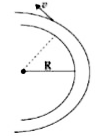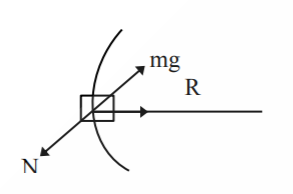Upside down racing: A modern race car is designed so that the passing air pushes down on it, allowing the car to travel much faster through a flat turn in a Grand Prix without friction failing. This downward push is called negative lift. Can a race can have so muchh negative lift it could be driven upside won on a long ceiling, as done fictionally by a sedan in the first Men in Black movie?
Figure represents a Grand Prix race car of mass m=600 kg as it travels on a flat in a circular arc of radius R=100m. Becuase of the shape of the car and the wings on it, passing air exerts a negative lift →FL

downward on the car. The coefficient of static friction between the tires and the track is 0.75. (Assume that the forces on the four tires are identical).
a. If the car is on the verge of sliding out of the turn when its speed is 28.6 m/s what is the magnitude of the negative lift →FL, acting downward on the car?
b. The magnitude FL of the negative lift on a car depends on the square of the car's speed v2, just as the drag force does. Thus the negative lift on the car here is greater when the car travels faster, as it does on a straight section of track. What is the magnitude of the negative lift for a speed of 90 m/s?
1. A centripetal force must act on the car because the car is moving around a circular arc, that force must be directed toward the center of curvature of the arc (here, that is horizontally).
2. The only horizontal force acting on the car is a frictional force on the tires is a frictional force.
3. Because the car is not sliding, the frictional force must be a static frictional force →fs.
4. Because the car is on the verge of sliding the magnitude fs is equal to the maximum value fs,max=μsFN, where FN is th magnitude of the normal force →FN acting on the car from the track.
Radial calculations: The frictional force →fs is shown in the free body diagram of fig. It is in the negative direction of a radiual axis r that always extends from the center of curvature through thecar as the car moves. The force produces a centripetal acceletation of magnitude v2/R. We can relate the force and acceleration by writing Newton.s second law for components along the r axis (Fnet,r=mar) as
−fs=m(−v2R)
Substituting fs,max=μsFN for fs leads us to
μsFN=m(v2R)
Vertical calculations: Next let.s consider the vertical forces on the car. The normal force →FN is directed up, in the positive direction of the y axis in fig. The gravitational force →Fg=m→g and the negative life →FL are directed down. The acceleration of the car along the y axis is zero. Thus we can writee Newton.s second law for components along the y axis (Fnet,y=may as
FN−mg−FL=0
or FN=mg+FL
Combining results:
Now we can combine our results alogn the two axes by substituting Eq. for FN in Eq.. Doing so and then solving for FL lead to
FL=m(v2μsR−g)
=(600kg)((28.6m/s)2(0.75)(100m)−9.8m/s2)
=663.7N≈660N
b. FL is proportional to v2.
Calculationis: Thus we can write a ratio of the negative lift FL,90 at v=90m/s to our result for the negative lift FL at v=28.6m/s as
FL,90FL=(90m/s)2(28.6m/s)2
Substituting our known negative lift of FL=663.7N and solving for FL,90 give us
FL,90=6572N≈6600N
Upside down racing: The gravitational force is of course, the force to beat if there is a chance of racing upside down,
Fg=mg=(600kg)(9.8ms2)
=5880N
With the car upside down, the negative lift is an upward force of 6600N, which exceeds the downward 5880N. Thus the car could run on a long ceiling provided that it moves at about 90m/s (=324 kmh/h=201mi/h). However, moving that fast while right side up on a horizontal track is dangerous enough, so you are not likely to see upside down racing except in the movies.
Topper's Solved these Questions
- BOOK - RESNICK AND HALLIDAYCHAPTER - CIRCULAR MOTIONEXERCISE - PROBLEMS56videos
CIRCULAR MOTION
- BOOK - RESNICK AND HALLIDAYCHAPTER - CIRCULAR MOTIONEXERCISE - PRACTICE QUESTIONS(SINGLE CORRECT CHOICE TYPE)40videos
CIRCULAR MOTION
- BOOK - RESNICK AND HALLIDAYCHAPTER - CIRCUITSEXERCISE - Practice Questions (Integer Type)3videos
CIRCUITS
- BOOK - RESNICK AND HALLIDAYCHAPTER - CURRENT AND RESISTANCEEXERCISE - Practice Questions (Integer Type)3videos
CURRENT AND RESISTANCE
Similar Questions
A modern gran -prix racing car of masses m is travelling on a flat track in a circular arc of radius R with a speed v. If the coefficient of static friction between the tyres and the track is μs, then the magnitude of negative lift FL acting downwards on the car is : ( Assume forces on the four tyres are identical and g = acceleration due to gravity )
 View Solution
View SolutionA circular race track is banked at 45∘ and has a radius of 40 m. at what speed does a car have no tendency to slip? If the coefficient of friction between the wheels and the track is 12, find the maximum speed at which the car can travel round the track without skidding.
View Solution
Knowledge Check
- Question 1 - Select One
Does he race cars?
AIs racing of the cars done by him?BAre cars raced by him?CDoes he the racing of cars?DAre race cars done by him? - Question 2 - Select One
A car is moving with velocity v on circular turn of radius R. Mass of the car is m. Evaluate the negative lift (FL) acting on the car
 Amv2μR−2mgBmv22μR−2mgCmv2μR−mgDmv23μR−mg
Amv2μR−2mgBmv22μR−2mgCmv2μR−mgDmv23μR−mg - Question 3 - Select One
A race car will make one lap around a circular track of radius R. When the car has traveled halfway around the track, what is the magnitude of the car's displacement from the starting point ?
A2RBRCπRD2πR
A circular race track of radius 400 m is banked at an angle of 10∘ . If the coefficient of friction between the wheels of a race car and the road is 0.2 , what is the (i) optimum speed of the race car to aviod wear and tear on its tyres .
maximum permissible speed to aviod slipping ?View SolutionA roller-coaster car enters the circular-loop part of the ride. At the very top of the circle (where the people in the car are upside down), the speed of the car is v and the acceleration points straight down. If the radius of the loop is r and the total mass of the car (plus passenger) is m, find the magnitude of the normal force exerted by the track on the car at this point.
View SolutionA man of mass m is standing on a stationary flat car of mass M. The car can move without friction along horizontal rails. The man starts walking with velocity v relative to the car. Work done by him
View SolutionWho was the first European to designate Aryanas a race ?
View SolutionA man of mass m is standing on a stationary flat car of mass M. The car can move without friction along horizontal rails. The man starts walking with velocity v relative to the car. Work done by him
View Solution

